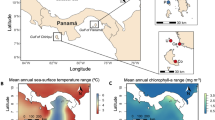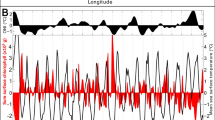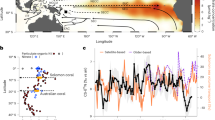Abstract
Upwelling across the tropical Pacific Ocean is projected to weaken in accordance with a reduction of the atmospheric overturning circulation1, enhancing the increase in sea surface temperature relative to other regions in response to greenhouse-gas forcing. In the central Pacific, home to one of the largest marine protected areas and fishery regions in the global tropics, sea surface temperatures are projected to increase by 2.8 °C by the end of this century2,3,4. Of critical concern is that marine protected areas may not provide refuge from the anticipated rate of large-scale warming, which could exceed the evolutionary capacity of coral and their symbionts to adapt5. Combining high-resolution satellite measurements6,7, an ensemble of global climate models4 and an eddy-resolving regional ocean circulation model8, we show that warming and productivity decline around select Pacific islands will be mitigated by enhanced upwelling associated with a strengthening of the equatorial undercurrent. Enhanced topographic upwelling will act as a negative feedback, locally mitigating the surface warming. At the Gilbert Islands, the rate of warming will be reduced by 0.7±0.3 °C or 25 ± 9% per century, or an overall cooling effect comparable to the local anomaly for a typical El Niño, by the end of this century. As the equatorial undercurrent is dynamically constrained to the Equator, only a handful of coral reefs stand to benefit from this equatorial island effect. Nevertheless, those that do face a lower rate of warming, conferring a significant advantage over neighbouring reef systems. If realized, these predictions help to identify potential refuges for coral reef communities from anticipated climate changes of the twenty-first century.
This is a preview of subscription content, access via your institution
Access options
Subscribe to this journal
Receive 12 print issues and online access
$209.00 per year
only $17.42 per issue
Buy this article
- Purchase on Springer Link
- Instant access to full article PDF
Prices may be subject to local taxes which are calculated during checkout





Similar content being viewed by others
References
Vecchi, G. A. & Soden, B. J. Global warming and the weakening of the tropical circulation. J. Clim. 20, 4316–4340 (2007).
Clement, A. C., Baker, A. C. & Leloup, J. Patterns of tropical warming. Nature Geosci. 3, 8–9 (2010).
Xie, S-P. et al. Global warming pattern formation: Sea surface temperature and rainfall. J. Clim. 23, 966–986 (2010).
IPCC Climate Change 2007: The Physical Science Basis (eds Soloman, S. et. al) (Cambridge Univ. Press, 2007).
Hughes, T. et al. Climate change, human impacts, and the resilience of coral reefs. Science 301, 929–933 (2003).
Esaias, W. E. et al. An overview of MODIS capabilities for ocean science observations. IEEE Trans. Geosci. Remote Sensing 36, 1250–1265 (1998).
McClain, C. R., Feldman, G. C. & Hooker, S. B. An overview of the SeaWiFS project and strategies for producing a climate research quality global ocean bio-optical time series. Deep-Sea Res. II 51, 5–42 (2004).
Shchepetkin, A. F. & McWilliams, J. C. The regional ocean modeling system: A split-explicit, free-surface, topography-following coordinates ocean model. Ocean Model. 9, 347–404 (2005).
Vecchi, G. A. et al. Weakening of tropical Pacific atmospheric circulation due to anthropogenic forcing. Nature 441, 73–76 (2006).
Fisheries and Aquaculture Department The State of World Fisheries and Aquaculture (Food and Agriculture Organization of the United Nations, 2008).
Laurs, R. M., Fiedler, P. C. & Montgomery, D. R. Albacore tuna catch distributions relative to environmental features observed from satellites. Deep-Sea Res. 31, 1085–1099 (1984).
Pauly, D. & Christensen, V. Primary production required to sustain global fisheries. Nature 374, 255–257 (1995).
Xie, S-P., Liu, W. T., Liu, Q. & Nonaka, M. Far-reaching effects of the Hawaiian Islands on the Pacific Ocean–atmosphere system. Science 292, 2057–2060 (2001).
Feldman, G. C., Clark, D. & Halpern, D. Satellite color observations of the phytoplankton distribution in the eastern equatorial Pacific during the 1982–83 El Niño. Science 226, 1069–1071 (1984).
Eden, C. & Timmermann, A. The influence of the Galápagos Islands on tropical temperatures, currents and the generation of tropical instability waves. Geophys. Res. Lett. 31, L15308 (2004).
Karnauskas, K. B., Murtugudde, R. & Busalacchi, A. J. The effect of the Galápagos Islands on the equatorial Pacific cold tongue. J. Phys. Oceanogr. 37, 1266–1281 (2007).
Gove, J. M., Merrifield, M. A. & Brainard, R. E. Temporal variability of current-driven upwelling at Jarvis Island. J. Geophys. Res. 111, C12011 (2006).
Messié, M., Radenac, M-H., Lefèvre, J. & Marchesiello, P. Chlorophyll bloom in the western Pacific at the end of the 1997–1998 El Niño: The role of the Kiribati Islands. Geophys. Res. Lett. 33, L14601 (2006).
Carton, J. A. & Giese, B. S. A reanalysis of ocean climate using simple ocean data assimilation (SODA). Mon. Weath. Rev. 136, 2999–3017 (2008).
Johnson, G. C., Sloyan, B. M., Kessler, W. S. & McTaggart, K. E. Direct measurements of upper ocean currents and water properties across the tropical Pacific Ocean during the 1990’s. Prog. Oceanogr. 52, 31–61 (2002).
Reynolds, R. W. et al. Daily high-resolution blended analyses for sea surface temperature. J. Clim. 20, 5473–5496 (2007).
Reynolds, R. W., Rayner, N. A., Smith, T. M., Stokes, D. C. & Wang, W. An improved in situ and satellite SST analysis for climate. J. Clim. 15, 1609–1625 (2002).
Wittenberg, A. T., Rosati, A., Lau, N-C. & Ploshay, J. J. GFDL’s CM2 global coupled climate models—part 3: Tropical Pacific climate and ENSO. J. Clim. 19, 698–722 (2006).
Karnauskas, K. B., Johnson, G. C. & Murtugudde, R. An equatorial ocean bottleneck in global climate models. J. Clim. 25, 343–349 (2012).
Philander, S. G. H., Hurlin, W. J. & Seigel, A. D. Simulation of the seasonal cycle of tropical Pacific Ocean. J. Phys. Oceanogr. 17, 1986–2002 (1987).
DiNezio, P. N. et al. Climate response of the equatorial Pacific to global warming. J. Clim. 22, 4873–4892 (2009).
Donner, S. D., Kirata, T. & Vieux, C. Recovery from the 2004 coral bleaching event in the Gilbert Islands, Kiribati. Atoll Res. Bull. 587 (2011); available at http://hdl.handle.net/10088/11729.
Penven, P., Marchesiello, P., Debreu, L. & Lefevre, J. Software tools for pre- and post-processing of oceanic regional simulations. Environ. Modell. Softw. 23, 660–662 (2008).
Atlas, R. et al. The effects of marine winds from scatterometer data on weather analysis and forecasting. Bull. Am. Meteorol. Soc. 82, 1965–1990 (2001).
Smith, T. M., Reynolds, R. W., Peterson, T. C. & Lawrimore, J. Improvements to NOAA’s historical merged land–ocean surface temperature analysis (1880–2006). J. Clim. 21, 2283–2296 (2008).
Acknowledgements
We thank the US National Science Foundation for support and D. Oppo and R. Murtugudde for reading and providing comments on a draft of the manuscript. Ocean colour data were acquired through the National Aeronautics and Space Administration ocean colour Giovanni web site. IPCC climate model outputs were acquired from the World Climate Research Program CMIP3 archive, hosted by the Lawrence Livermore National Laboratory. Optimal interpolation SST data sets were acquired from the NOAA National Climate Data Center FTP portal. The ROMS code, including the ROMSTOOLS MATLAB toolbox, was generously provided by L’Institut de recherche pour le développement on their web site (http://roms.mpl.ird.fr). This study was supported by NSF OCE #1031971.
Author information
Authors and Affiliations
Contributions
K.B.K. and A.L.C. designed the study, K.B.K. conducted the high-resolution ocean model experiments, and K.B.K. and A.L.C. analyzed the results and wrote the paper together.
Corresponding author
Ethics declarations
Competing interests
The authors declare no competing financial interests.
Rights and permissions
About this article
Cite this article
Karnauskas, K., Cohen, A. Equatorial refuge amid tropical warming. Nature Clim Change 2, 530–534 (2012). https://doi.org/10.1038/nclimate1499
Received:
Accepted:
Published:
Issue Date:
DOI: https://doi.org/10.1038/nclimate1499
This article is cited by
-
Coral reef ecological pump for gathering and retaining nutrients and exporting carbon: a review and perspectives
Acta Oceanologica Sinica (2023)
-
Heat accumulation on coral reefs mitigated by internal waves
Nature Geoscience (2020)
-
Resilience of Central Pacific reefs subject to frequent heat stress and human disturbance
Scientific Reports (2019)
-
Some environmental and biological determinants of coral richness, resilience and reef building in Galápagos (Ecuador)
Scientific Reports (2019)
-
Seasonal variability and long-term trends of the surface and subsurface circulation features in the Equatorial Indian Ocean
Environmental Monitoring and Assessment (2019)



